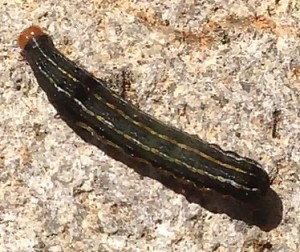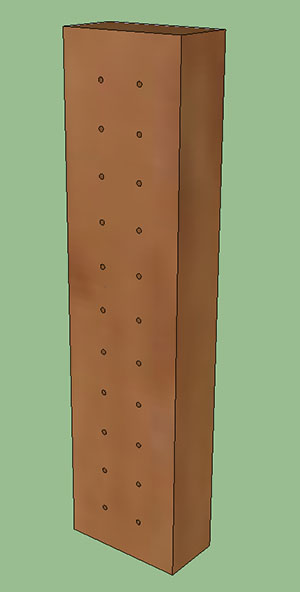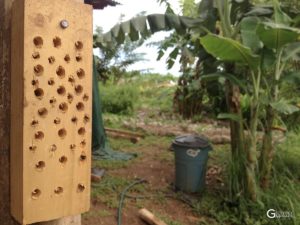Artificial Wasp Nest for Caterpillar Control
There are hundreds of species of wasps in the jungles of Costa Rica. Many or most are predators of other insects, and we’ve learned that they’re already being used in other parts of Costa Rica to control flies.
A Plague of Caterpillars that Eat Spinach and Arugula
 We have several types of small caterpillars that bother our plants. One, in particular, is black with stripes, and comes by the hundreds, singling out our arugula (#1 favorite) and spinach (#2 choice). We don’t know what they’re called or even what type of moth or butterfly they turn into. But none of the organic sprays such as garlic and chili powder, seem to deter them. So far, all we’ve been able to do is try to squish them by hand once they get large enough to see them.
We have several types of small caterpillars that bother our plants. One, in particular, is black with stripes, and comes by the hundreds, singling out our arugula (#1 favorite) and spinach (#2 choice). We don’t know what they’re called or even what type of moth or butterfly they turn into. But none of the organic sprays such as garlic and chili powder, seem to deter them. So far, all we’ve been able to do is try to squish them by hand once they get large enough to see them.
So, what if we can encourage these wasps to live in greater numbers around here so they’ll help us out? Such an army of wasps could act as a constant deterrent towards all forms of caterpillar species coming to the farm, and perhaps keep the number of caterpillars that menace our farm down to smaller numbers. Or in a fantasy world, one could imagine a box that I could open, releasing hundreds of wasps, which would kill all the caterpillars on a particular plant, and then fly back into their box for later use. This instant “cause and effect” would be very satisfying, but is obviously not the way it would work. Instead, the wasps would need to be part of a continuous cycle of life, interacting both with the farm and the surrounding jungle. Their numbers would fluctuate with the amount of food they find and the natural seasons. If they killed all the caterpillars around, I’d expect that their numbers would drop, and more caterpillars would come, and then their population would swell once more. The hope is that we can find a balance, a way to encourage more of them to live near our plants. They would forage in the jungle when food is scarce on the farm, and when the caterpillar swarms come, they will target this more local food source.
But first, can I find a wasp that targets the caterpillars eating our plants?
Discovery of a Wasp that Kills Our Caterpillars
 If you live in Costa Rica and you have a house that’s open to the elements, you’ll probably discover that there are various types of wasps that collect mud to build small nests in your home. I had one type that was obsessed with building its nests on the backside of one particular hanging cast iron pan. Something about the shape was very attractive to these wasps.
If you live in Costa Rica and you have a house that’s open to the elements, you’ll probably discover that there are various types of wasps that collect mud to build small nests in your home. I had one type that was obsessed with building its nests on the backside of one particular hanging cast iron pan. Something about the shape was very attractive to these wasps.
Recently, I found that there’s a type of wasp that favors the small round hole in electric outlets. You know, that third hole in grounded plugs. We always have a window open at our house for the cat to go in and out, and these wasps will fly in and stuff mud into the holes of our outlets.
Upon closer inspection when I cleaned one of these out, I found that the wasp would place its egg inside, and then stuff it with food for its larva to eat when it hatches. What food? This wasp had stuffed 7-8 small caterpillars/worms into the hole! After leaving a cache of nutrition inside for its baby, the wasp plugs the hole with mud, and flies off. I don’t yet know the complete lifecycle of this wasp, but I’m assuming the parent wasp never comes back and a few weeks or months later, a baby wasp that has changed from egg to larva to adult wasp, or perhaps a pupa, will emerge from behind the mud wall, to leave the hole and seek food, a mate, and continue the life-cycle of its species.
So this got me thinking…
A Lucky Day
Immediately after writing the above, I went outside to check through the gardens, and found another infestation of caterpillars in a group of spinach plants in our mandala keyhole garden. This is a kind of caterpillar that favors spinach and arugula, and a plague of them decimated our arugula a few weeks back in the shade structure. We were nearly helpless to stop them. When they’re small, they are so well camouflaged in the plants that they’re nearly invisible. It’s only after they’ve eaten a large number of our plants that they turn blacker and larger so we can see them and crush them by hand.
So today I discovered a small black wasp buzzing around the spinach, and I filmed it with my I-phone camera. To my delight, it attacked a smaller green caterpillar hidden on the underside of the plants, and I was able to get this on film, which you can see below.
The following video is embedded at 640px, but a much higher quality one at 1080×720 is available at youtube here: Wasp Attacking Caterpillar Video
Wasp Attacking Caterpillar Video
How can we get more of these wasps to live nearby and help us with routine cleaning up of smaller caterpillars from our plants?
Artificial Wasp Nest Design
 My design for the artificial wasp nest is hardly a work of architectural genius. It’s basically just a two-by-four with a bunch of holes drilled in it. in later versions, we plan to have a painting party with our volunteers and decorate them beautifully. Hopefully our garish and possibly psychedelic colors won’t turn off our waspy clients.
My design for the artificial wasp nest is hardly a work of architectural genius. It’s basically just a two-by-four with a bunch of holes drilled in it. in later versions, we plan to have a painting party with our volunteers and decorate them beautifully. Hopefully our garish and possibly psychedelic colors won’t turn off our waspy clients.
We can take pieces of scrap wood, and drill holes that are perhaps one inch deep, with the same diameter as the prong hole of the electric outlets that these wasps seem to favor. We could put these around the farm and inside the shade structure to see if the wasps will start to use them, and hopefully, each new wasp grub will mean a whole lot fewer caterpillars on our vegetables.
So now we must put the idea into action and see if we can find the right type of material, hole size and depth, and position of these artificial nests, to see if the right type of wasps will start using them.
Results
 The design works! The first wasp houses we made filled up with mud wasp larvae very quickly, and still seem to be working almost a year later. We plan to put more of these around the farm and do some experiments about where to place them. We’ve been putting them covered areas, or under large tree branches, and that seems to be successful. A photo of the wasp house being used is on the right.
The design works! The first wasp houses we made filled up with mud wasp larvae very quickly, and still seem to be working almost a year later. We plan to put more of these around the farm and do some experiments about where to place them. We’ve been putting them covered areas, or under large tree branches, and that seems to be successful. A photo of the wasp house being used is on the right.
You may notice that there are 2-3 sizes of holes and all of them are being used. I think it would have been beneficial to sand the hole edges a bit to try to remove the splinters. Some of these you can see have already been used and then vacated.
NOTE: There’s another type of larger wasp that builds mud nests, usually placing them vertically as tubes on the side of your house or in my case, they loved hanging frying pans. Opening up these mud tubes revealed they were filled with spiders! Not good! Each was larvae is killing spiders that may eat dozens of harmful insects on the farm. So, I recommend removing these types of mud wasps but leave the little ones that place their larvae in mud-filled holes.
Other Caterpillar Eaters
Lacewings: The larvae of the lacewing insect loves to suck the life out of caterpillars. Read more about this bug so you can recognize their eggs and larvae to help them do their job in your plants. They love aphids too: Lacewing article
Chickens? I wanted to mention that we carried eight chickens into the shade structure to let them loose on the caterpillars, hoping that their sharp eyes and beaks would decimate our wiggly green enemies. However, we were very disappointed to find that after a few trial pecks, our chickens ignored the caterpillars, even when we put them in a pile on the ground, hoping to train them to recognize them as a food source. The chickens seemed to favor, above all other things in the garden, the grass that was growing on the ground.
Bats? Since we haven’t seen the butterflies that these caterpillars turn into, I’m guessing they may be a type of moth, which will only be flying around at night. So, if we encourage more bats to live on the farm, will they eat more of the moths that come at night to lay their eggs on our spinach? This seems like a great solution to me. They might eat the wasps too, except that the wasps would be asleep at night when the bats are active.
Birds? Chickens don’t like these caterpillars, but perhaps some native birds will. Supposedly, one way to attract birds is to attract lots of butterflies. So, we will be planting types of flowers to attract them, such as Lantana and Alacran. I just hope those butterflies that are attracted aren’t the same ones whose caterpillar form eats our plants!?!
Wasps that Kill Flies
At Leaves and Lizards eco-lodge in Arenal, they are able to buy, at their local cooperativa (agricultural products store) small packages with the eggs of wasp larvae. These are produced in Colombia for farmers like them who have pigs, chickens, etc. These wasp larvae hatch and will kill the grubs/larvae of flies/moscas that live in the poop of farm animals. The owners told me they think they reduce the number of flies buzzing around by 80-90%. We have tried to find these to buy them, and haven’t been able to locate them. We heard that the company who had them stopped importing them.














